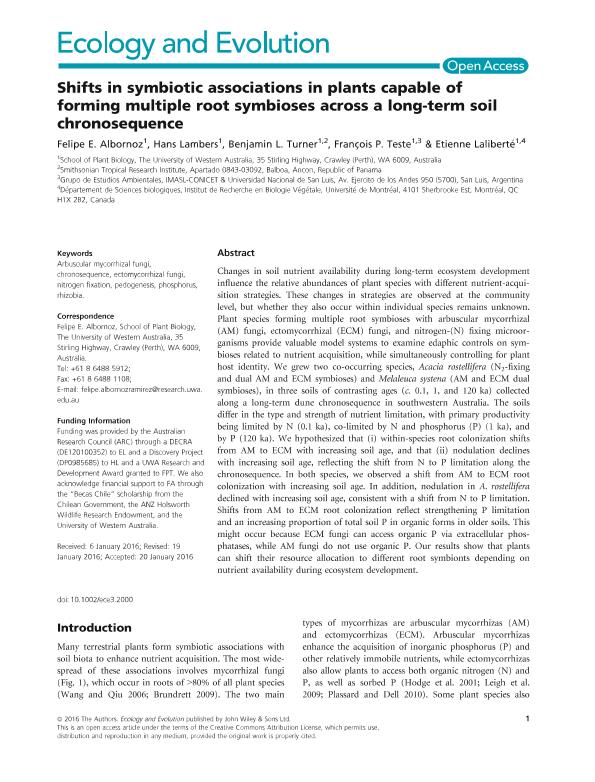Artículo
Shifts in symbiotic associations in plants capable of forming multiple root symbioses across a long-term soil chronosequence
Fecha de publicación:
04/2016
Editorial:
John Wiley & Sons Ltd
Revista:
Ecology and Evolution
ISSN:
2045-7758
Idioma:
Inglés
Tipo de recurso:
Artículo publicado
Clasificación temática:
Resumen
Changes in soil nutrient availability during long-term ecosystem development influence the relative abundances of plant species with different nutrient-acquisition strategies. These changes in strategies are observed at the community level, but whether they also occur within individual species remains unknown. Plant species forming multiple root symbioses with arbuscular mycorrhizal (AM) fungi, ectomycorrhizal (ECM) fungi, and nitrogen-(N) fixing microorganisms provide valuable model systems to examine edaphic controls on symbioses related to nutrient acquisition, while simultaneously controlling for plant host identity. We grew two co-occurring species, Acacia rostellifera (N2-fixing and dual AM and ECM symbioses) and Melaleuca systena (AM and ECM dual symbioses), in three soils of contrasting ages (c. 0.1, 1, and 120 ka) collected along a long-term dune chronosequence in southwestern Australia. The soils differ in the type and strength of nutrient limitation, with primary productivity being limited by N (0.1 ka), co-limited by N and phosphorus (P) (1 ka), and by P (120 ka). We hypothesized that (i) within-species root colonization shifts from AM to ECM with increasing soil age, and that (ii) nodulation declines with increasing soil age, reflecting the shift from N to P limitation along the chronosequence. In both species, we observed a shift from AM to ECM root colonization with increasing soil age. In addition, nodulation in A. rostellifera declined with increasing soil age, consistent with a shift from N to P limitation. Shifts from AM to ECM root colonization reflect strengthening P limitation and an increasing proportion of total soil P in organic forms in older soils. This might occur because ECM fungi can access organic P via extracellular phosphatases, while AM fungi do not use organic P. Our results show that plants can shift their resource allocation to different root symbionts depending on nutrient availability during ecosystem development. Changes in soil nutrient availability during long-term ecosystem development influence the relative abundances of plant species with different nutrient-acquisition strategies. We grew two co-occurring mycorrhizal plant species in three soils of contrasting ages (c. 0.1, 1, and 120 ka). In both species, we observed a shift from AM to ECM root colonization with increasing soil age, consistent with a shift from N to P limitation. Here, we show that plants shift their resource allocation to different root symbionts depending on nutrient availability during ecosystem development.
Archivos asociados
Licencia
Identificadores
Colecciones
Articulos(IMASL)
Articulos de INST. DE MATEMATICA APLICADA DE SAN LUIS
Articulos de INST. DE MATEMATICA APLICADA DE SAN LUIS
Citación
Albornoz, Felipe E.; Lambers, Hans; Turner, Benjamin L.; Teste, Francois; Laliberté, Etienne; Shifts in symbiotic associations in plants capable of forming multiple root symbioses across a long-term soil chronosequence; John Wiley & Sons Ltd; Ecology and Evolution; 6; 8; 4-2016; 2368-2377
Compartir
Altmétricas




